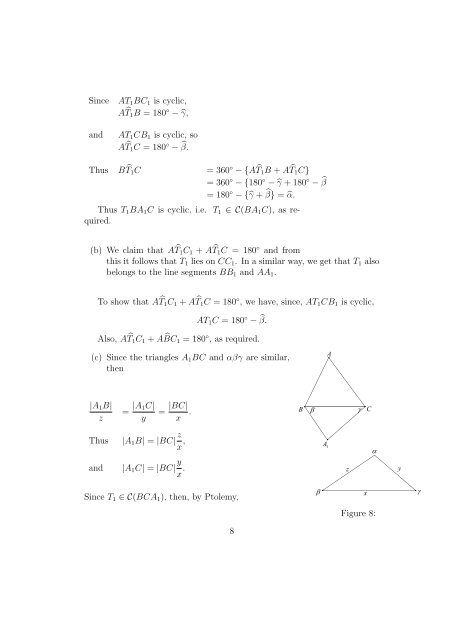2. Equilateral Triangles
2. Equilateral Triangles
2. Equilateral Triangles
You also want an ePaper? Increase the reach of your titles
YUMPU automatically turns print PDFs into web optimized ePapers that Google loves.
Since AT1BC1 is cyclic,<br />
A T1B = 180 ◦ − γ,<br />
and AT1CB1 is cyclic, so<br />
A T1C = 180 ◦ − β.<br />
Thus B T1C = 360 ◦ − {A T1B + A T1C}<br />
= 360 ◦ − {180 ◦ − γ + 180 ◦ − β<br />
= 180 ◦ − {γ + β} = α.<br />
Thus T1BA1C is cyclic, i.e. T1 ∈ C(BA1C), as required.<br />
(b) We claim that A T1C1 + A T1C = 180 ◦ and from<br />
this it follows that T1 lies on CC1. In a similar way, we get that T1 also<br />
belongs to the line segments BB1 and AA1.<br />
To show that A T1C1 + A T1C = 180 ◦ , we have, since, AT1CB1 is cyclic,<br />
AT1C = 180 ◦ − β.<br />
Also, A T1C1 + A BC1 = 180 ◦ , as required.<br />
(c) Since the triangles A1BC and αβγ are similar,<br />
then<br />
|A1B|<br />
z<br />
= |A1C|<br />
y<br />
= |BC|<br />
x .<br />
Thus |A1B| = |BC| z<br />
x ,<br />
and |A1C| = |BC| y<br />
x .<br />
Since T1 ∈ C(BCA1), then, by Ptolemy,<br />
8<br />
Figure 8:

















